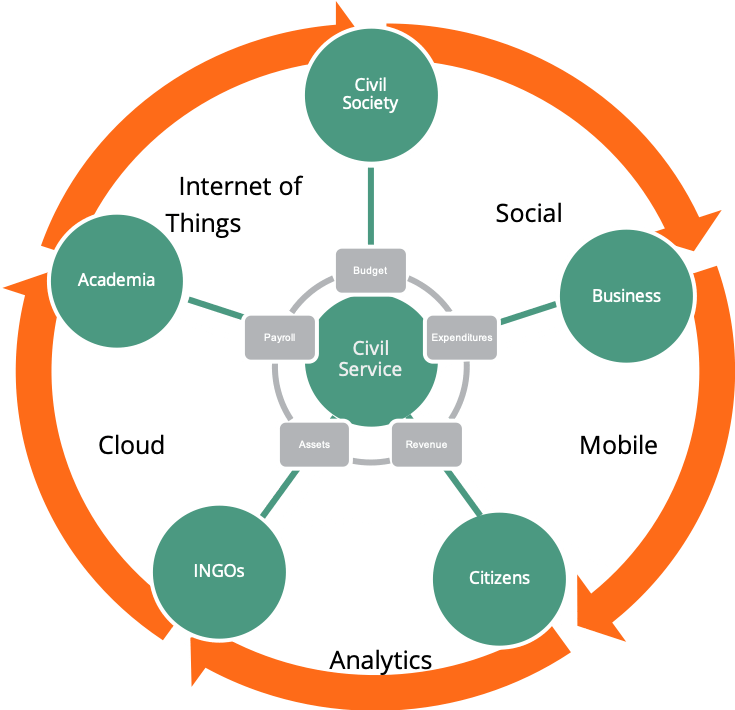Governments often encounter the digital organizational change management “perfect storm”. This storm combines the challenges of large enterprise software projects in government with digital and organizational transformation. These projects become even more complex when implemented in Emerging Market and Developing Economies (EMDEs) countries.
Governments are no longer satisfied with improving “systems of record”. The move to “systems of engagement” requires new ways of looking at technology. An effective change management methodology is imperative to transform from ‘doing’ digital things to ‘becoming’ digital.
The Gartner Group observes that “digital government is government designed and operated to take advantage of digital data in optimizing, transforming, and creating government services.” This is the purpose of “systems of engagement” in government.

How Does Government Digital Transformation Improve Citizen Wellbeing?
Government digital transformation enables service delivery improvements which ultimately result in greater citizen wellbeing. The efficiency and effectiveness of digital include lower costs, greater productivity, and improved citizen satisfaction. There’s no question that 24/7 government digital services can reduce government costs while reducing the time burden on citizens and businesses.
Comprehensive “digital thinking” goes beyond improved services to engagement. Engaging civil society to overcome difficult problems. Engaging businesses to create better infrastructure for sustainable growth. Open innovation. Governments who leverage the combined wisdom of citizens are more likely to overcome the challenges of our VUCA world.
What Challenges Face Governments Embarking on a Digital Transformation Journey?
The Gartner Group has observed that “while digital transformation is having a major impact on private sector organizations worldwide, its presence in government remains at an embryonic level of development.” Effective organizational change management for digital transformation in government requires key challenges to be overcome:
- Operational core: Digital transformation means fundamentally changing processes, not digitizing existing processes for incremental improvement. Everyone in government must work to make it a success.
- Planning cycle changes: Government cycles for planning, budgeting and project initiation will need to change which introduces “how things have always been done” change resistance.
- Hierarchy changes: Digital organizations move fast which means reducing reliance on hierarchies, and levelling hierarchies requires collaboration. This changes the entire structure of government career planning.
- Cult of the ‘expert’: Public servant specialization and experience can perpetuate the view that outsiders do not have sufficient expertise to provide insight yet governments also seek external specialists as advisors. This creates environments where citizen engagement is considered lip service rather than empathetic exercises.
- Government-wide: Digital transformation respects no organizational boundaries. Digital transformation introduces change to the nature of planning, from silo to whole-of-government which introduces the anxiety that power and influence will be reduced.
- Eliminate legacy: Government organizations are hampered by the reliance on legacy technologies and structures. Many public servant careers are predicated on legacy technologies and legacy thinking. Digital transformation threatens the status quo.
- Lack of implicit certainty: Many government investments are made based on the fictional certainty of positive future results. Public investments are made and contracts tendered based on a “waterfall” set of milestones. The notion of digital transformation with experimentation, learning and “failing fast” is not culturally compatible with risk-averse government organizations.
This is why organizational change management is so critical to government digital transformation projects.
What is the Process of Digital Transformation in Government?
Effective government digital transformation is not for the faint of heart. This comes at a time when citizens are suspicious of government digital investments. There are fundamental changes to government IT planning and execution necessary to succeed. The process of digital transformation in government must include:
- Long-term vision: More digitally mature organizations have long-term coherent digital strategies. This must cross organizational boundaries to overcome multiple traditional, disconnected technology solutions with limited ability to obtain a consistent view of citizens. Digital objectives should be aligned with government priorities.
- No new rules: Public sector organizations tend to rely on a familiar but ultimately unhelpful set of remedies which often result in more rules to prevent bad things from happening. The problem with adding more rules is that it creates a compliance-based culture in which staff do not feel empowered to make decisions, and the organization becomes stymied by a growing pool of ‘checkers’ and a shrinking pool of ‘doers.’
- Citizen journey mapping: The public sector needs a deep understanding of why citizens need to interact with the government, the life event triggers, the value of each interaction in the context of a citizen’s life events and needs, as well as the broader implications of a life event for government services. This means that the citizen journey across organizations needs to be seamless.
- Agile Methods: Governments must be willing to remake products, processes and policies around what citizens want. This requires agile iteration and experimentation. It also requires a focus on “customer experience” or CX.
- Data-driven: Data must be used in driving digital transformation initiatives and as an overall outcome. Governments must use digital to better instrument and monitor processes to improve services.
Government Digital Transformation Cannot be Avoided
It could be argued that governments could avoid digital transformation because citizens have no alternatives for public services. On the other hand, digital experience improvements from the private sector sets citizen expectations. The government is not immune to changes in the IT environment. Citizen demand for better services will drive government investment in digital transformation.
Government Transformation Change Management
Governments should digitize high-volume services first, they should digitize labour-intensive, costly processes before others. Change is hard and there are no magic bullets. Change management for digital transformation in government requires:
- Compelling change story: Engagement with employees needs to have context and vision. There needs to be a burning platform that resonates with everyone to motivate the change.
- Governance design: Digital transformation needs to have organizational design directly linked to government objectives. This means that the ways of working change, but the mandate remains the same. Digital transformation projects can be viewed as core.
- Multiple-Year Planning: Stable structures, regular budgeting and modest reward systems make leaders poorly prepared for the much faster-paced, more challenging work of digital transformation. Therefore, PFM reform with multiple-year expenditure frameworks is necessary.
- Leadership empowerment: Senior government bureaucrats and Ministers do not design and implement digital transformation but they must enable organizational change management by empowering the project’s leadership.
- Establish boundaries: Empowerment requires everyone to understand the project’s mission boundaries.
- Experimentation incentives: Empowerment needs to enable experimentation and agile processes.
- Leverage investments: Governments should build on efforts, even failed initiatives to leverage the investment.
- Talent Incentives: Digital transformation should become an accelerated career path for public servants.
- Transparency: Transparency about digital transformation goals and outcomes is necessary not only for the buy-in of the civil service but also to build trust with the public.
- Data-driven governance: Advanced analytics should be used in digital transformation.
- Build on small wins: Governments should design and build small blocks of business value that can be reconfigured and recombined. This approach of small wins reduces change resistance.
